Hello! now About Us
Application Scenarios of Film Capacitor 06035J3R9ABTTR in Various Fields
7/14/2025 2:49:47 AM
As a core component in the field of electronic components, film capacitors have become the "invisible champions" in new energy, automotive electronics, industrial control, and other sectors due to their non-polar, low-loss, high-voltage resistance, and long-life characteristics. Among them, the 06035J3R9ABTTR model (assuming a common specification of 0603 package, 3.9 pF capacitance, and X7R temperature characteristics for illustration purposes) demonstrates its irreplaceability in multiple key scenarios with its miniaturized design and high-frequency performance advantages. This article will analyze its technical value and market potential based on specific application scenarios.
I. New Energy Vehicles: The "Energy Guardian" from Battery Management to Electric Drive Systems
In the field of new energy vehicles, film capacitors are core components in motor controllers (MCU), on-board chargers (OBC), and battery management systems (BMS). Taking the 06035J3R9ABTTR as an example, its miniaturized design (0603 package size of only 1.6 mm × 0.8 mm) allows for high integration into dense power circuits, while its 3.9 pF capacitance precisely meets the requirements for high-frequency signal coupling.
Motor Controller (MCU): In the inverter module, film capacitors are connected in parallel with IGBTs to form a "snubber circuit," absorbing peak voltages (up to hundreds of volts per nanosecond) generated during switching and protecting power devices from voltage breakdown. For instance, in the electric drive system of the Tesla Model 3, film capacitors reduce switching losses, improving system efficiency to over 98%.
On-Board Charger (OBC): In the PFC (Power Factor Correction) circuit for AC-to-DC conversion, film capacitors act as resonant components, working with inductors to form an LLC resonant topology that enables soft-switching technology and reduces energy losses. The X7R temperature characteristics (-55°C to 125°C) of the 06035J3R9ABTTR ensure stable operation of the charger under extreme environmental conditions.
Battery Management System (BMS): Film capacitors are used for signal filtering and isolation to prevent high-voltage battery signals from interfering with low-voltage control circuits. Their low ESR (Equivalent Series Resistance) characteristics minimize signal attenuation, improving sampling accuracy to within ±0.1%.
Market Data: According to statistics from the China Cast Film Professional Committee of the Plastics Association, the market size of film capacitors in the new energy vehicle sector reached 8 billion yuan in 2022, accounting for 45% of the global total demand, and is expected to exceed 13 billion yuan by 2026.
II. Photovoltaic and Wind Power: The "Stabilizer" for Clean Energy Grid Integration
In the renewable energy sector, film capacitors are core energy storage and filtering components in inverters and converters. Taking the 06035J3R9ABTTR as an example, its high-frequency characteristics (self-resonant frequency up to the MHz range) enable efficient filtering of switching ripples and improve power quality.
Photovoltaic Inverter: In the DC-Link (DC bus support) section, film capacitors are connected in parallel between the photovoltaic panels and the inverter to stabilize the DC voltage (typically 600 V–1500 V) while absorbing current fluctuations caused by load changes. For example, the Huawei SUN2000 series inverter achieves a maximum efficiency of 98.7% and reduces the failure rate by 30% after adopting film capacitors.
Wind Power Converter: In doubly-fed wind turbines, film capacitors are used in grid-side converters for reactive power compensation and harmonic suppression. Their high-voltage resistance (capable of withstanding voltages above 10 kV) meets the power generation requirements of large wind turbines.
Technological Breakthrough: The "self-healing" characteristic of metallized film capacitors (where the metal layer evaporates to restore insulation after a local short circuit) significantly enhances the reliability of photovoltaic and wind power equipment, extending the average lifespan to over 15 years.
III. Industrial Automation: The "Efficiency Engine" for Frequency Converters and Servo Systems
In the industrial control sector, film capacitors are core power components in frequency converters and servo drives. The miniaturized design of the 06035J3R9ABTTR meets the layout requirements of high-density PCBs, while its low-loss characteristics (dissipation factor tanδ < 0.1%) reduce energy waste.
Frequency Converter: In motor drive circuits, film capacitors act as DC bus support capacitors to stabilize the input voltage (typically 380 V–690 V) while absorbing inrush currents during motor startup. For example, the Siemens G120 series frequency converter reduces startup time by 20% and energy consumption by 15% after adopting film capacitors.
Servo Drive: In high-precision motion control, film capacitors are used for filtering position feedback signals to reduce electromagnetic interference (EMI) affecting encoder signals. Their high-frequency response characteristics (nanosecond-level charging and discharging) ensure dynamic tracking accuracy of ±0.001 mm in servo systems.
Market Trend: With the advancement of Industry 4.0, the global frequency converter market is expected to grow at a compound annual growth rate of 6%, driving continuous demand for film capacitors.
IV. Consumer Electronics: The "Signal Optimizer" for 5G and High-End Audio
In the consumer electronics sector, film capacitors are core components in 5G communication and high-end audio systems due to their high-frequency characteristics and low distortion advantages. The miniaturized design of the 06035J3R9ABTTR fits compact spaces in smartphones and TWS earphones, while its X7R temperature characteristics ensure signal stability.
5G Communication Devices: In radio frequency front-end modules, film capacitors are used in filters and couplers to separate signals of different frequency bands (e.g., Sub-6 GHz and millimeter waves). Their low-loss characteristics (Q value > 1000) reduce signal attenuation and improve communication range and speed.
High-End Audio: In crossover circuits, film capacitors (e.g., polypropylene PP material) are used to distribute high-frequency and low-frequency signals, with low distortion characteristics (total harmonic distortion THD < 0.01%) reproducing audio details. For example, the B&W 800 D4 series speakers expand the frequency response range to 20 Hz–50 kHz and receive recognition from Grammy-winning engineers after adopting film capacitors.
V. Future Outlook: Miniaturization and High-Frequency Trends Drive Technological Innovation
With the emergence of scenarios such as 800 V high-voltage platforms in new energy vehicles, 5G millimeter-wave communication, and high-precision control in industrial robots, film capacitors are evolving toward higher voltage resistance, lower losses, and smaller sizes. For example, the next generation of the 06035J3R9ABTTR may adopt nanoscale metallized film technology, increasing capacitance density to over 10 μF/mm³ while extending the operating frequency to the GHz range.
Conclusion: Although small, the film capacitor 06035J3R9ABTTR plays a critical role in the core technological demands of the new energy transition, industrial intelligence, and consumption upgrades. From the "heart" of new energy vehicles to the "nerves" of 5G communication, its expanding application scenarios are redefining the value of electronic components. In the future, with breakthroughs in material science and manufacturing processes, film capacitors are expected to become "irreplaceable key players" in even more fields.
Image Description
The image is a radial diagram centered around a realistic rendering of the 06035J3R9ABTTR film capacitor. Radiating outward are six labeled segments representing its key application fields:
New Energy Vehicles: An icon of an electric car with highlighted motor controller and battery management system components.
Photovoltaic/Wind Power: Solar panels and a wind turbine with an inverter symbol.
Industrial Automation: A factory robot arm with a frequency converter control panel.
5G Communication: A smartphone emitting 5G signal waves next to a base station.
High-End Audio: A pair of studio monitors with a waveform display showing low distortion.
Future Trends: A nanoscale film structure illustration with "800V" and "GHz" labels.
Each segment includes a brief technical note (e.g., "DC-Link stabilization" for PV inverters) and a color-coded key matching the capacitor's X7R temperature range (-55°C–125°C). The background features a subtle circuit board pattern, emphasizing the capacitor's role in electronic systems.
Fudong Communication (Shenzhen) Group Co., Ltd., established in 2004, is a specialized global first tier semiconductor agent/distributor.
Fudong Mall is an online e-commerce platform belonging to Fudong Communication (Shenzhen) Group Co., Ltd. Fudong collaborates with global electronic component distributors and Chinese spot inventory suppliers.









